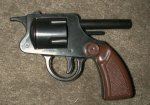imported post
psychophipps wrote:
I find it interesting that the U.S. is the only military out there not happy with 9mm NATO. The brits have used it for years and have no issues with the cartridge and niether do any number of other well-equiped and highly trained militaries around the world.
The truth, despite the hype, is that handguns aren't as effective at stopping people as rifles. Full stop. It doesn't matter if you hit your target with a .22 or a .454Casull, you need to hit the CNS or a major blood-bearing organ to stop your target with maximum efficiency. The idea that a simple swap to a harder to use for some people, lower capacity, and perhaps most importantly, lower penetration of light cover cartridge will magically turns these well-known facts around is ludicrous.
Mark(psycho)Phipps( HAHAHA! )
I would agree with most of what you said, but there has been some research done into the effectiveness of 9mm verses other cartridges. While clearly law enforcement application differer from military application, it could be argued that for pistols the requirement are similar enough to justify cross applicability of the study data.
The FBI Wounding Factors and Effectiveness study determined that-
Kinetic energy does not wound. Temporary cavity does not wound. The much discussed "shock" bullet impact is a fable and "knock down" power is a myth. The critical element is penetration. The bullet must pass through the large, blood bearing organs and be of sufficient diameter to promote rapid bleeding. Penetration less than 12 inches is too little, and in the words of two of the participants in the 1987 Wound Ballistics Workshop, "too little penetration will get you killed". Given desirable and reliable penetration, the only way to increase bullet effectiveness is to increase the severity of the would by increasing the size of the hole made by the bullet. Any bullet which will not penetrate through vital organs from less than optimal angles is not acceptable. Of those that will penetrate, the edge is always with the bigger bullet.
In the final analysis they selected the 10mm as a compromise between diameter and penetration. IT was found to be too powerful for many LEOs to routinely shoot reliably, and it was decided to go with less power to solve that issue. Ultimately this lead to the development of the .40S&W that is popular today.
Interestingly, the .40S&W is virtually identical to the .45 auto on paper. The major reason that the FBI selected the lower caliber round was to increase the capacity of the magazine. Presumably this allows for more shots on target, and compensates for the smaller diameter.
But you mentioned cover. In the testing mentioned above, it was determined that windshields and similar light cover will deflect the higher velocity 9mm, while a .40S&W or .45 Auto will shatter and defeat the cover. Moreover, in defeating the cover, these heavier bullets lost less velocity due to their greater inertia.
Arguably a combat pistol is used in much the same way as LEO pistol. Guard duty, motor pool drivers mechanics and similar personnel would tend to actually use a pistol more than the average soldier. For most military the pistol is a backup weapon, or close quarters tool. But it should still be an effective tool.
The reason we are using the 9mm today, is because NATO uses it and there was an idea that all NOTO countries should have compatible ammunition. This decision has nothing to do with effectiveness. The reason that NATO uses 9mm is because it is a common caliber in europe. It is common in europe, not because it is particularly effective compared to other calibers, but because of munitions manufacturing restrictions, and fighting philosophies dating back to the turn of the 20th century.
It must be recognized that in the last 100 years humans have actually gotten larger on average. This relates to improvement in diet and other factors. This tells us that the bullets used in the first half of the 20th century might not be as effective on human targets grown in the 21st century.
Today there are a number of pistols chambered for cartridges in the .40 to .45 caliber range (10mm-11.43mm. Most of those cartridges are better performers than the 9mm carried by NATO today. Many of those pistols are of double stack design and carry from 14 to 20 rounds in the magazine.
If I have a choice between providing our troops with the most effective sidearm or providing the ability to swap ammo with NATO, I will choose most effective every time. At some point in our history we have gone to war with most NATO countries. There is no guarantee this would never happen again. I certainly do not want to make weapons selections for our troops based on the idea that we won't.
Regards


